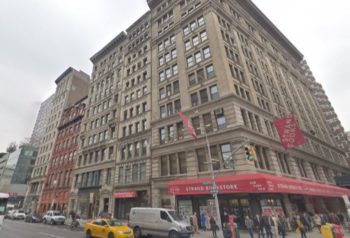
Five of the seven buildings designated as individual landmarks on June 11, 2019. Image Credit: Google Maps
Commissioners commented on the importance of communicating the benefits of landmarking to the public. On June 11, 2019, the Landmarks Preservation Commission voted to designate seven buildings as individual landmarks on Broadway south of Union Square. The buildings are located at 817 Broadway, 826 Broadway, 830 Broadway, 832 Broadway, 836 Broadway, 840 Broadway, and 841 Broadway. The seven buildings were constructed between 1876 and 1902. The buildings housed garment manufacturers, book publishers, and even a movie studio and reflected a time when Manhattan was continuing to grow north.
The first public hearing for the designation was held on December 4, 2018. Another public hearing was held on February 19, 2019 at the request of the owners of 826 Broadway to allow for more testimony. For CityLand’s prior coverage of the designation process for these seven buildings, click here.
There was some controversy before the vote to designate 826 Broadway. The building is home to the Strand Bookstore. The owners of the Strand – who also own the building – have campaigned against the designation over concerns that landmarking would pose a threat to the Strand’s ability to survive as a business. At the public hearings, the owners and several employees shared concerns about their ability to change signage, layouts and make repairs to the building given the time-consuming process of seeking approval from Landmarks. The attorney for the Strand, Alexander J. Urbelis of Blackstone Law Group, reiterated these concerns on June 11th after being allowed to briefly go on the record right before the vote. Urbelis stated, “May your conscious dissuade you from taking part in the downfall of New York’s greatest and most beloved bookstore.”
Several commissioners commented in response to the concerns from the Strand. Commissioner Michael Goldblum stated, “The testimony in opposition to this building, in my opinion, represents a failure on our part that the preponderance of misinformation surrounding the perils of designation so pervades this incredibly articulate, well-informed body of New Yorkers. Eleven thousand and counting. It’s shocking to me, and deeply disappointing because it doesn’t in any way, shape or form coordinate with my own view, both as a practitioner in New York City and now as a commissioner for nine years with the burden placed on the building owner when compared to its benefit to the City.” Goldblum also stated that he believed the burdens are “minimal to the extreme”, that landmarking gives owners new benefits like access to grants and that “we, as the Commission, should redouble our efforts to make known to the public the relative burdens and wealth of benefits to what we do.” A few other commissioners shared similar opinions.
At a press conference on Wednesday, June 12, 2019, when asked about the designation of the Strand building Mayor Bill de Blasio replied, “I think when the City hears someone – and if you talk to the folks at Landmark Preservation – they’ve spent real time trying to address this. And they hear someone’s concern and they show them point by point why it does not have to create an additional cost. I do trust that the City is being real responsive here. Everyone respects Strand quite a bit and I believe that we can prove that this is not going to be the problem that she [Strand owner Nancy Bass Wyden] projects it to be.”
During the vote, Landmarks Preservation Commission Chair Sarah Carroll discussed working with the Strand to create a Master Plan to help streamline future work done on the building.
By the end of the hearing, the commissioners voted 8-0 to designate 826 Broadway as a landmark along with the other six Broadway buildings.
In a press release, Commission Chair Sarah Carroll stated, “I am delighted that the Commission has voted to designate these seven Broadway buildings as individual landmarks. Each of these seven buildings has strong architectural and historical significance and together they reflect the history and importance of Broadway’s development south of Union Square. They tell the history of the area, from its industrial past with the garment industry and labor rights movement to its cultural significance with the film industry and the internationally beloved Strand Bookstore.”
Council Member Carlina Rivera stated, “I want to thank LPC for their landmark designation of these seven buildings along Broadway, which comes following years of effort from community members seeking recognition of this corridor’s historical character. These buildings represent the pinnacle of Industrial Age architecture south of Union Square, and together they will further preserve and acknowledge lower Broadway’s legacy as a center of New York City’s manufacturing might. I look forward to collaborating with the Commission and local stakeholders on additional opportunities to recognize the architectural and cultural treasures in our neighborhoods.”
By: Veronica Rose (Veronica is the CityLaw fellow and a New York Law School graduate, Class of 2018.)

